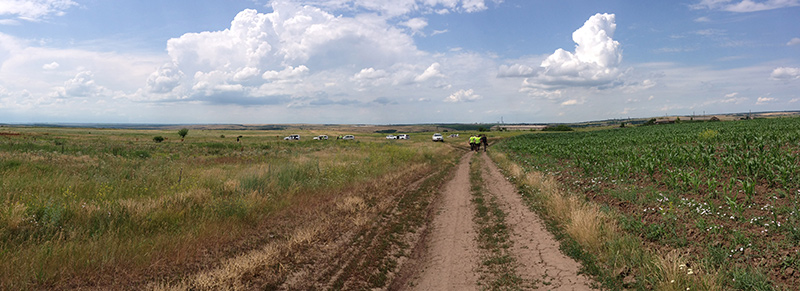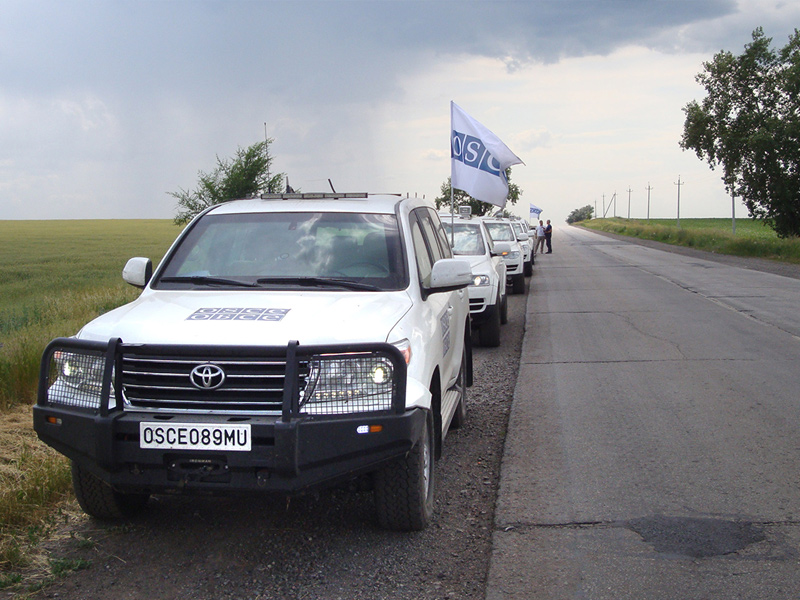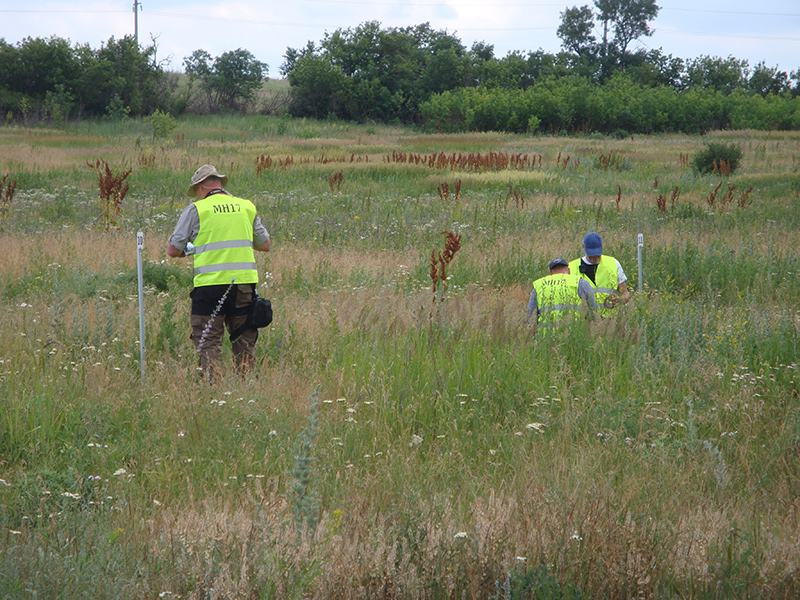Collecting soil samples in disputed territory
Doing everything that is possible
How do you perform a criminal investigation within a disputed border region, where gun battles are taking place almost daily? Research leader Daan Noort speaks about the mission to Eastern Ukraine where, amongst other things, soil samples were collected from the alleged launch sites.
“Endless fields of grain”, that’s what Daan Noort (Colonel with the Royal Netherlands Marechaussee and operational head of Forensic Research National Police) saw in Eastern Ukraine last summer. The disputed area used to be the granary of the former Soviet Union, and this summer it is still full of corn. Besides golden cornstalks in a sun-drenched landscape, Noort saw beautiful historic cities and self-confident people.
But gun battles could be heard daily, sometimes less than a kilometre away. To and from the border, investigators saw kilometres-long queues. At one stage near a military complex, they received a warning that they had better make a hasty departure.
If Noort had to summarize his experience in one word, it would be, ‘surreal’.
June 2016

Soil samples investigation in Eastern Ukraine.
Soil samples and network measuring
Last summer, Noort was in Eastern Ukraine for 10 days with his research team. The most important objective of this mission was taking soil samples in order to determine the alleged launch site of the missile and undertaking technical research to determine the location of cell towers and to identify and document the telephone network in Eastern Ukraine.
Beforehand, it was unclear whether the soil samples would yield useful information. After all, the fields had been covered in snow and probably been ploughed and sown again. Torrential rain might have washed away important trace evidence. It would be extraordinary to find trace remains of rocket fuel or other traces of a possible launch.
“We still went looking for that, because it is important to do everything within your capabilities”, said Noort, “criminal investigation is simply nothing more or less than independent research and establishing the truth, to find both incriminating and exculpatory evidence”.
Convoy
On 12 June 2015 the team flew from Eindhoven to Kharkiv in a Hercules aircraft.
Three days later, investigators drove in a convoy of four vehicles to the research area.
To do so, they had to visit the two self-proclaimed people's Republics, known as Donetsk and Luhansk. The Netherlands does not maintain official contacts with local authorities there. Therefore, the team was accompanied by the Organization for Security and Co-operation in Europe (OSCE).
In the Donetsk region - where the remains of the MH17 came down - Noort met the man who had earlier fulfilled an important role in enabling the 'recovery mission' into the Ukraine to recover the victims, their personal belongings and plane debris.
To look each other in the eye
It was agreed that the OSCE would carry out any negotiations with the local authorities. The role of the mission leader was limited to giving a technical explanation. “The approach in these situations is always focused on gaining confidence,” says Noort, “do not do anything that you would not allow yourself either. We came with advanced research material, while they have to rely on outdated gear. Without properly explaining what our equipment is for, amongst others, network measurement equipment could also be mistaken for espionage material. To still bring this kind of things to a successful conclusion, you need to look each other in the eye. Part of that is that you respect each other as professionals.”
Eventually, the man asked his superiors to cooperate with the mission. And so we managed to enter the research locations in the Donetsk region. “The freedom we eventually got to be allowed to do our work showed something of confidence in our approach and intent,” says Noort.

Column during soil samples investigation in Eastern Ukraine under the protection of the OSCE.
Launching sites
In the Donetsk region, the team visited all indicated soil research sites that play a role in the possible scenarios developed by the Joint Investigation Team (JIT). The JIT also examines those scenarios in other ways.
Beforehand the investigators had the positions of all locations available and had also worked the locations out on road maps. “We didn't want to go wandering around on site, if for example, our GPS equipment couldn't make contact with satellites.”
Nearly a year later they could finally secure the desired soil samples from the clay soil at locations the leaders of the JIT had specified.
Independent
The team also investigated the telephone network. They managed to do so in different places and along several routes in the Donetsk region. Unfortunately, the team was not allowed to conduct a technical investigation into the network and cell towers in the region of the self-proclaimed People's Republic of Luhansk.
“According to one scenario, known from open sources, a missile installation would have been driven from the border through this area to Donetsk,” explains Noort, ”with measurements we wanted to verify if that information can indeed be correct. For the criminal investigation it is desirable to also make those independent observations oneself.”
Even with much insistence the team didn't manage to enter this region. In talks with the OSCE, the representatives of the self-proclaimed People's Republic did not allow access. “It is unfortunate that this part didn't work out, but we have high hopes that the measurements we have been able to do in the Donetsk region have yielded sufficient results. Moreover, the most important thing is that we did try.”
Chapter
After ten days the mission was completed. After returning to the Netherlands, Noort and the team submitted their report. The secured soil samples were transferred to the team leader of the JIT. Chemical research and analysis should reveal whether the result is supportive, with incriminating or exculpatory evidence.
“In my 36-year career with the Royal Netherlands Marechaussee this mission is a very special chapter,” says Noort. “As the only team, we have been on the alleged sites of the launch, searching for evidence of an act that has caused so much grief to those directly involved, an event that has had a huge impact on our society and the world around us. Recognizing that nothing of what you see over there actually needs to be so, we have therefore done everything in our power.”

Soil samples investigation in Eastern Ukraine.
Soil samples and network measurements in Eastern Ukraine
Last year the Netherlands initiated a research mission to eastern Ukraine. The mission aimed to gather evidence to support or reject various scenarios on the circumstances of the air disaster. The mission was facilitated by the OSCE. (Organization for Security and Co-operation in Europe).
The Police and Defence forces asked Colonel Daan Noort (Royal Netherlands Marechaussee) to lead the mission. Defence provided the logistical support and security. The team consisted of experts in the fields of telecommunications and forensics.


